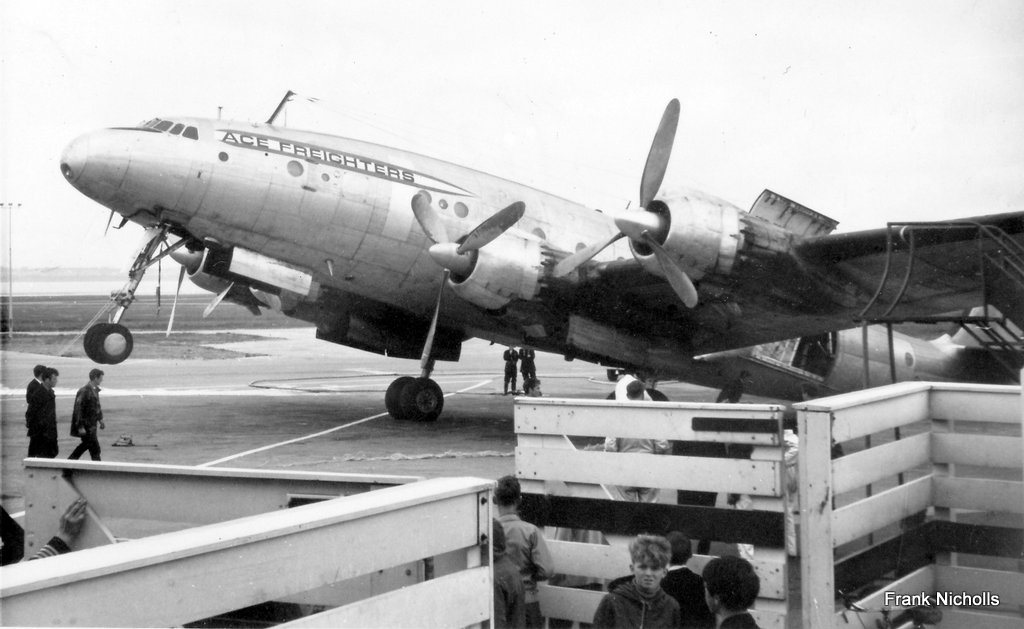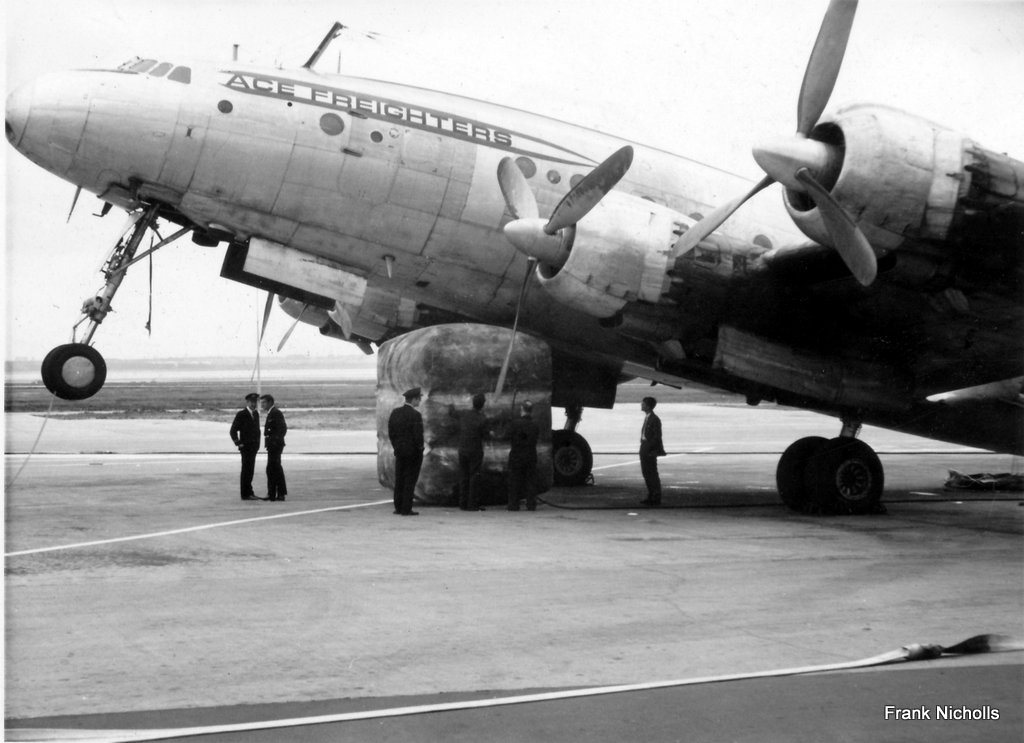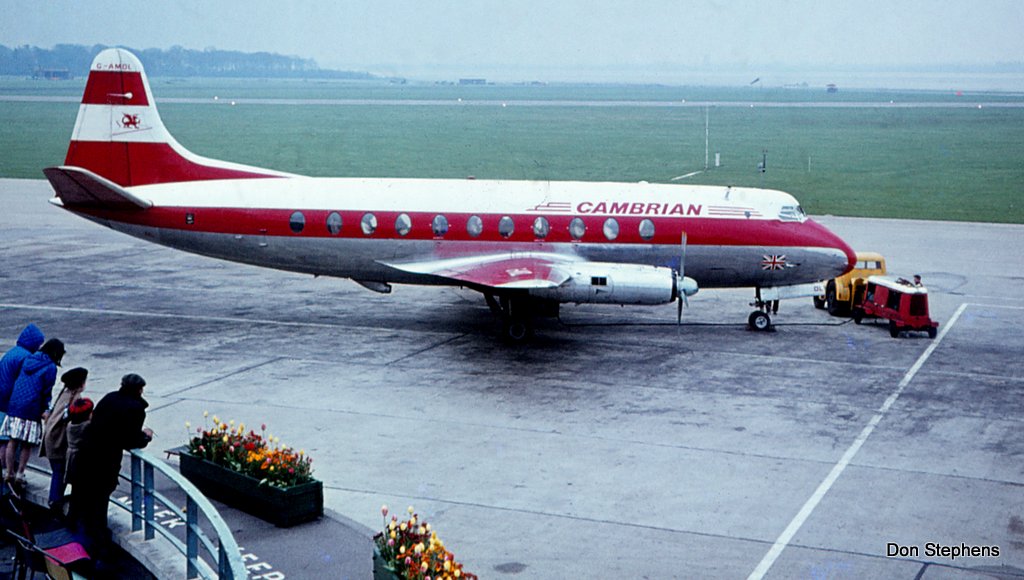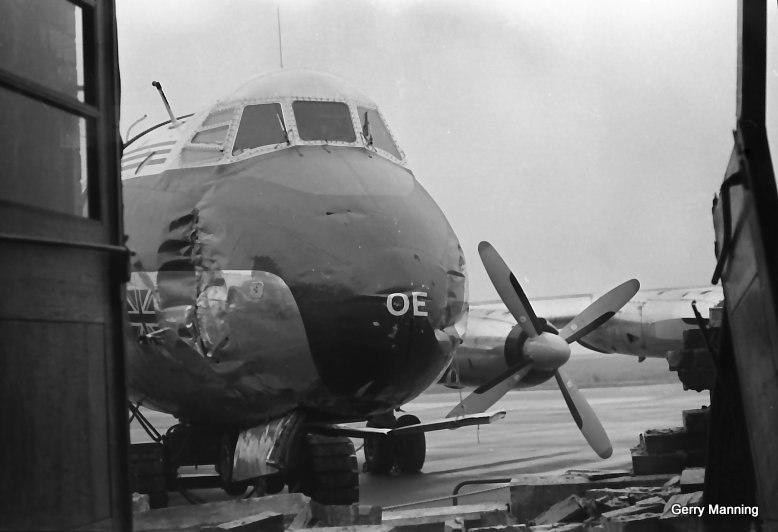|
|
Post by viscount on Sept 1, 2015 13:48:28 GMT 1
The recent discussion regarding both Gates and dates, has encouraged Frank Nicholls to explore his loft, and come up with previously unpublished (indeed for very many years, unseen) photos of both the Cambrian Viscount and Ace Freighters Constellation incidents. These were taken on a square format, basic camera and following scanning have been cropped, re-contrasted and re-touched using Picasa. Cambrian Viscount 701 G-AMOE entered Gate 2, Friday 15th July 1966   Interesting to read the newspaper article then look at these photos, two taken just after the nose had been extracted from the door way. The doorway is around 2 to 3 ft above the apron and a ramp around 3 to 4ft wide leading upto it, which explains why the nose undercarriage leg has been damaged so far behind the main door-frame 'pinch' marks by the cockpit. The damage to the aircraft is clear once pulled back onto the apron. Clever little crawler, that presumably the Fire Service produced, to remove the aircraft without further damage being caused. Ace Freighters L-749A Constellation 'tail tip', Saturday 2nd July 1966    The Constellation tail-tip being the result of part of a load of cigarettes being carried during a Docks and Merchant Seaman's strike, shifting. When forward momentum and the prop wash 'lift' over the wings ceased, with an altered C of G the aircraft gently settled onto its tail. This is shown clearly on these photos, both from the Balcony and from ground level beside the former Car-Ferry Sheds and white plank fencing. Indeed I could be the kid in the gate, with back to the camera - certainly I was there on the day. The large air-bag was placed under the nose to prevent damage to the undercarriage should the aircraft have regained its normal stance too quickly. Final photo shows the Connie back to normal - indeed damage was so slight the aircraft was back in service the following morning. The Douglas C-54/DC-4 always had the potential for this to happen, and a metal strut was placed between tail and ground when unloading passengers. The only other tail tip I'm aware of, other than this Connie, was to a Trislander also at Liverpool Airport, but no photos have yet emerged of that incident (though see top of page 4). Many thanks to Frank for coming up with these fascinating photos. I am always on the look-out for 60s, 70s and 80s photos, colour or b&w and will shortly be launching major threads on the 60s decade at Speke that will require illustration of both the regular and the unusual. Do you have any shots, even of 'rubbish' quality, hidden away? |
|
Deleted
Deleted Member
Posts: 0
|
Post by Deleted on Sept 1, 2015 23:11:09 GMT 1
Great photos. I've seen the Ace Freighters ones before, but not the OE ones. The Ace Freighters pictures were used for many years in ramp crew training, for obvious reasons!
I remember the OE incident very well. There we were having a cup of tea and discussing the upcoming football at the weekend to the accompanying sound of four Rolls-Royce Darts,(nothing unusual in that of course), when there was a hell of a bang and the building shook. The Darts were quickly powered down and we ran out to see what had happened. A rather shaken Tommy Rise (who was chief engineer at the time) emerged from the door and said that the brakes had failed, exactly as the Echo article says.
The ones who had the greatest shock were the Met Office staff, who occupied the office next door to the gate.
The gate opposite, Gate 1, did indeed lead to the staff car park and the bonded store. Some things don't change however. It is still necessary to fit the tail strut to the ATR 42 and 72 before passengers can disembark!
|
|
|
|
Post by viscount on Feb 9, 2018 21:32:16 GMT 1
One 'incident' in the above list is in 1977; during the pressure of a stream of arrivals, one pilot did not absolutely obey 'bats', the result a slow speed excursion off the concrete of the apron 'finger' onto hard grass. No damage was done and the aircraft later successfully pushed-back onto the apron. Red faces all round and no doubt some Gallic expletives! I just love the improvisation in the third photo - with the nose slightly down, the rear 'air-stairs' would not quite reach the ground. The front door was unsafe for passenger use as any steps would be insecure on the grass, leave the passengers on board all day, no! - answer find a spare pallet and use it as the final step and everyone is happy. Took me a while after the original listing was posted to rediscover and add-in the registration, now photos of the aftermath have been turned-up. If anyone comes across photos of incidents and accidents at Liverpool Airport, do please post, or at least contact me by PM.    This post also serves as a 'bump-up' for this popular thread, as all my images that were removed by 'Photobucket' have now, some 8 months later have now not only been replaced, but also added to here. Between May 2013 and February 2018 this thread has clocked up 12,635 'hits', and the count will climb higher now that it is illustrated again. The photos were lost again during the second half of 2019 and when reposted in July 2021 the visit count has reached 19,900 making this one of the most consulted threaded on the Nostalgia Section. For more photos and information about LFC v St.Etienne in March 1977 there is a thread on nwan: derbosoft.proboards.com/thread/28395/airlift-etienne-fans-march-1977 |
|
|
|
Post by viscount on Mar 24, 2018 8:50:40 GMT 1
Well, at the top of my previous post I invited anyone with photographs of aircraft accidents and incidents at Liverpool Airport to come forward. What I did not expect was an incident that seems to be completely erased from memory and about which I have never, knowingly, seen anything in print. Barry is adamant that the photo is at Speke, but unfortunately cannot come up with a date.  So where is the aircraft, apart from the obvious that it is in a farmer's field? The answer is that it is in the overshoot of runway 17, over by Speke Hall. The 17/35 runway that ran from near Bryant and Mays towards Speke Hall. In 1965 this runway was extended at the 35 end by 1000ft, then curved around as the 'link' taxiway to the 09 end of the 1966 'new runway'. Before 1965 there was farmland between the 35 runway end and Speke Hall property boundary. The photo is likely from somewhere down by the Sailing Club, certainly the track to the sailing club provided the access for Barry to get into a position to use his camera. Then the question posed is why, when we can see a stout concrete post and chain link fence, is the aircraft apparently undamaged? If it had torn through a 6ft fence, the aircraft would have been badly damaged, if not written off - so would be in the written record. Those around at the time may recall that the main runway at the 26 end along Speke Hall Avenue had a low wooden 'frangible' fence across the centre-line. Indeed even today 27 has a double wooden frangible fence under the centre-line - the only point where there is no high security fencing around the airport (but with even higher security brambles!). So almost certainly the 35 end of the cross-runway also had a low wooden fence which easily collapsed, with only minimal damage to the aircraft. While I have stated that I can find no record in documents, Phil Butler's transcripts of the ATC Airport Logs, do for 3rd October 1956 mention EI-ACD Douglas C-47 Dakota of Aer Lingus as diverting in with engine trouble. In the days of radial piston engines 'engine trouble' was often 'code' for an in-flight engine shut down. It could be that the aircraft floated, so landed long, along 17 and could not stop before over-running the shortish runway end and on into the field. On one engine a go-around was not an option. The two snags to such an early date is that the aircraft is in the Aer Lingus 'green top' scheme that I associate with 1958 onwards and Barry reckons that, as the photo is in colour it is much more likely early '60s than late '50s. The general scenario seems right: a long 'floated' landing on a short runway with a decision to go-around not made, the aircraft simply ran out of runway, then airfield, so through the fence and ended up 'next door' but with little damage done. Not that unusual in the '50s and into the early '60s before the runway extending/building frenzy to accommodate the new breed of jet airliners. I think an alternative, more dramatic, scenario of an engine failure on take-off roll, with the aircraft then failing to stop within the airport boundary is more likely to have been remembered, even if only as an 'urban legend'. A further scenario has been suggested, that of total or partial brake failure on landing - given the technology of the day quite possible, almost mundane, so not recorded as newsworthy (as it wasn't). An interesting 'snap' Barry - one which has caused you and I a considerable amount of head scratching and thank you for sharing it - maybe someone even knows the answer as to why and when the farmer found a Dakota in his field! |
|
|
|
Post by viscount on Jul 20, 2018 13:25:56 GMT 1
The main list (despite the distortion created on transfer of a wide Excel page to BB code on a forum) on page 1 of this thread remains a 'work in progress'. Thanks to 'Ste-t' I have been able to add in 4 fatal accidents during the 1930s. 10.6.36 G-ABZF; 11.4.37 G-AELD; 6.12.37 K5159; 1.5.38 G-AEMS and 13.2.40 G-AEHJ. I am sure that we still may not have all relevant accidents covered though, but now certainly have the great majority. Ste-t has uncovered these additions from two excellent web sources for 1930s aviation: www.rcawsey.co.uk/Accindex.htm takes you to a home page list, you select the year(s). A quite amazing lisiting of fatal air accidents pre War. Worth good trawl through if interested in air accidents pre 1940. www.airhistory.org.uk/gy/regn_G-E.html and www.airhistory.org.uk/gy/regn_G-A.html is an excellent list of all pre-war UK civil registration with owners (many are not covered on G-INFO due to a fire in the records office during the 1930s). Good to know others while researching other aspects of aviation and aircraft are also watching for additions to the list on nwan. |
|
|
|
Post by davecalveley on Jul 22, 2018 10:03:09 GMT 1
Spitfire productiom list mentions a Mk1 of 7 OTU serial k9851 as stalling on landing and tearing undercarriage off at Speke 10/12/40.....think there were 1 or 2 Sabre mishaps when the Canadian frames were being done by Airwork?.
regards Dave
|
|
|
|
Post by dovermire on Jul 22, 2018 13:40:33 GMT 1
Aviation Accidents and Incidents
with a direct link to
Liverpool Airport and locality 18.10.62 G-APID C-54D Skymaster Speke Transmeridian Flying Wheels-up landing. Repair on site by Scottish Aviation before ferried to landing Services Prestwick 10.11.62. This one caught my eye, I was 13 then and from memory, it was evening/night time and the C-54D was (I believe) doing a crew change for a ship. I was with a couple of other teenagers at the time, being shown round the control tower at Speke, can't really remember who the other young people were, but it was one of them, that had arranged the small tour. Remember being shown the radar screen and the blip that was G-APID, to be honest I couldn't see it, however, I remember the incident and how proffesional the controller(s) were when it happened, regretablly we were asked to leave just after the landing - happy days and hanger No50 for the club room. Dave O |
|
|
|
Post by vanguard on Jul 22, 2018 14:08:38 GMT 1
I also remember that wheels up landing.Somewhere i have a clipping from the Liverpool Echo of the aircraft being towed back on rescue bogies across the apron.  |
|
dee
New Member

Posts: 2
|
Post by dee on Apr 9, 2020 22:39:01 GMT 1
 Tommy Rise was a family friend for years. Wonderful man. Fond memories.
|
|
|
|
Post by vanguard on Apr 10, 2020 11:26:12 GMT 1
I to remember Tommy from my days at LPL from when i started in 1969 and not forgetting the other Cambrian eng.staff.
|
|
|
|
Post by viscount on Jul 27, 2021 14:17:58 GMT 1
I'm currently re-entering images into a number of the more popular posts in the Liverpool Nostalgia Section. As a "Bump Up" and also to record in this thread two incidents since the thread was first started, a couple of late 2019 images that have appeared on NWAN in the 'daily' Liverpool Movements thread of the time will serve to bring the coverage upto date.  Just as the aircraft swung around to leave the apron the rear of the wing impacted a mobile lighting unit. The damage to the flaps prevented the aircraft from flying away for repair. The incident occurred on 22nd September 2019, however due to red tape (believed to be the issuing of visas to engineering staff required to do a job no British engineers were qualified for) the spares and engineers did not arrive until mid December. After a short test flight and subsequent inspection and clearance to fly, the aircraft eventually departed on 27th December. The photo is taken on 9th October 2019 while awaiting repair. Presumably the damage was on the rear of the wing on the starboard side, as the port side looks fine, despite the steps for inspection being under the port wing!   On 11th December Global Express 6000 9H-VCM of VistaJet on arrival at 05:45 am with LFC's owner from the USA, the aircraft ran-off the 27 fast turn off and sank into soft ground. No one was hurt, however getting the heavy equipment and expertise together to move the airliner sized executive jet took time. It took some 15 hours before it was extracted from the mud and onto the hard surface. The airport was totally closed for around 20 hours as the tail was just into the 'runway exclusion zone', rendering the runway closed. Many scheduled flights were diverted, some delayed and few cancelled. These two images captured from TV news broadcasts. The aircraft was taken into one of the hangars for a total examination and the replacement of nose wheel leg. The aircraft departed after repair on 25th January 2020. |
|
|
|
Post by viscount on Aug 3, 2021 13:47:47 GMT 1
Eager to try an solve the conundrum of the Aer Lingus Dakota in the farmer's field, "Rob 125" who subscribes to a newspaper research site, found two incidents in the correct time-frame, 1958 and 1960, although neither was what he was looking for! The following information is gleaned solely from the "Liverpool Echo and Evening Express" reports.
Saturday, 4th August 1960
HOLIDAY DELAY AS PLANES COLLIDE ON GROUND AT CITY AIRPORT
At just after 9am a Douglas DC-4 of Starways with 58 passengers bound for Lourdes and Biarritz and a Douglas DC-3 of Aer Lingus with 32 passengers for Dublin were ready to depart together. The journalist does not apportion blame, but the DC-4 ended up with a dented 'nose cone' and the DC-3 with slight damage to the port wing. The Aer Lingus passengers were collected by a Viscount, diverted in while en route Bristol to Dublin, and left at 10:57; while a replacement aircraft was found by Starways and the passengers departed at 11:15.
Monday 2nd February 1958
TWO PLANES SABATOGED AT SPEKE - WATER PUT IN PETROL TANKS
The first incident was on Monday 2nd February before an Aer Lingus Dakota departed to Dublin, when 4 gallons of water was found in the tanks, the second on Friday 6th February after a Cambrian Air Services Dragon Rapide had refueled following arrival from Cardiff and was found to have 3 pints of water in the tank before departing to the Channel Islands with 4 passengers. Chief Inspector J.Sparks of Special Branch headed the investigation to solve the riddle of the water in the fuel and was in 'no doubt' that the aircraft had been interfered with. Samples of fuel and water were being sent to the forensic science labs at Preston for investigation.
No idea of the outcome of the 'sabotage', but both articles had good clear descriptive titles and kept very much to the facts, clearly the reporter had spoken to people involved, unlike the part informed hyperbole and speculation of today. Neither of these two incidents are sufficiently serious enough to warrantee inclusion in the tables earlier in the post, but having been 'found' are worth recording.
|
|
|
|
Post by viscount on Aug 24, 2021 11:41:50 GMT 1
Aftermath of the crash of Viscount G-AMOL, July 1965. .jpg) b.jpg) a.jpg) Don used to worry about the morality of having taken photos of an aircraft on which people had died just days previously. At least one of these shots has been used by FoLA a long time ago. They show the removal of pieces of G-AMOL to the AAIB at Farnborough on 'Queen Mary' transporters. They had parked on the airport for security overnight, before an early morning departure was by chance witnessed by Don. Photos dated Saturday 24th July 1965, the aircraft having rolled into Motacks factory while on late finals for 26 the Tuesday before.  G-AMOL while flying with Cambrian, seen at Liverpool on 28th April 1965. |
|
|
|
Post by viscount on Aug 25, 2021 10:30:59 GMT 1
The saga of 'Oscar Echo' goes on with a further three images of the aftermath of hitting Gate 2 nose on. After the accident the balcony was quickly cleared and closed, however there was still access to the Gate 2 area from inside the building and the cluttered gap between Gate 1 and No.1 hangar. I have seen an interesting shot from the Control Tower looking down on the incident, but have yet to trace the source. These fresh, although now fairly familiar images come from the camera of Gerry Manning, to whom many thanks. |
|
Deleted
Deleted Member
Posts: 0
|
Post by Deleted on Aug 26, 2021 9:47:14 GMT 1
In one of those peculiar twists of fate, the area where the remains of 'OL were parked could be seen from my bedroom window. Imagine my shock when I woke up, opened the curtains and saw the trailers. Today they would have been covered by plastic sheeting, but life was a little different in those days. Having prepared the cargo manifest for the outbound flight, I had a number of sleepless nights afterwards, especially when the people from Farnborough came and took away all the paperwork. My colleague who did the loadsheet (we are still good friends), similarly had many sleepless nights. Both of us were only 20 years old. I was waiting for the aircraft to arrive, because the crew were Cardiff-based and returning home the following day, so we had planned to go out for a few drinks. How things can change so quickly!
I have mentioned the 'OE incident previously on this thread. At a guess, I'd say that 'OE hit the terminal at about 20 mph, which doesn't sound much, but a terminal built in the 1930s is much stronger than a viscount built in the 1950s! We were all pleased that no blame was attributed to Tommy Rise, the engineer in charge. Tommy was one of life's characters and an excellent engineer. I have seen other photos of this incident, including one of a Cambrian hostie in full uniform pointing at the nose of 'OE, but I have no idea where they are now. Gerry - shouldn't you have been at school? lol!
The Aer Lingus DC-3 remains a mystery. I have spoken to the few people still alive who I know were around at the time, but to no avail. The only clue is in the crop growing in the field, which suggests early spring. A thought occurred to me that it might have been taken at Dublin, since I visited there so often and occasionally took my camera, but there were no other photos from Dublin with that one. It is a total one-off and I am as sure as I can be that it was taken at Speke. If I was still living in the same house, I would probably have all the information to hand...
|
|

























.jpg)
b.jpg)
a.jpg)



